Table of Contents
Why Use a Crate for a Giant Schnauzer?
There is a common misconception when it comes to buying crates for Giant Schnauzers. First-time pet parents would usually not agree with the idea of crate training. Some even think crate training is too cruel for the dog to endure. Well, dogs love freedom, but crate training has nothing to do with restrictions. In fact, crate training has many benefits, and you might not even know that you need it until you experience losing a pair of your shoes or see every corner of your home being chewed by your dog. Now you will learn how to choose the right crate size for Giant Schnauzer and you will benefit from proper crate training.
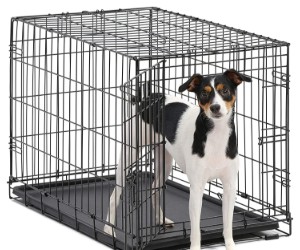
What Size Crate for a Giant Schnauzer?
You should always remember that Giant Schnauzers like to be on their own. Also, keep in mind that this dog is just as sensitive as other breeds when it comes to their haven. When choosing a crate, make sure that it has enough room for your dog to fully stretch his or her body, stand up and lie down comfortably.
So, the best size crate for an adult Giant Schnauzer is 48L x 30W x 33H. This is X-Large crate size, depending on the manufacturer’s size chart.
If you have a younger dog (about six months old) and you don’t want to change crates as he grows bigger, just ask the length of his parents. The crate must nor be shorter than the actual length of your Giant, the longer, the better. Manufacturers make the height and Height and width in conformity with the period. But if you want to be sure, just measure your dog’s height while sitting and diameter in lying position.
The crate should be high enough to allow your dog to sit and stand at full height. It should be wide enough for your dog to turn around and long enough for your dog to lie stretched out.
If you bought a large crate for growing up, your dog should have two corners for sleeping and playing. Dogs don’t want to soil where they sleep or eat. For sure, your dog will do best to hold his bladder when inside the crate. Ideally, the container that you will choose should be the exact size of your dog. You can just upgrade the size and buy another in the future as your puppy grows.
4 Reasons to Buy a Crate for Giant Schnauzer
- For puppy house training to develop discipline
- To prevent destructive behavior and teach positive habits
- To create a safe place for a pup where he can be free from stress
- To travel more secure and relaxed when dogs are crate trained properly
Types of Crate for Giant Schnauzer Puppy and Grown-Up
If you already know which crate type you’d like to buy, here is a list of the best in each category.
Best Metal Wire Crate for Home  | MidWest Homes for Pets Dog Crate
| Check Price |
|---|---|---|
Best Plactic Kennel  | Petmate Aspen Heavy-Duty Pet Kennel
| Check Price |
Best Heavy Duty Dog Kennel 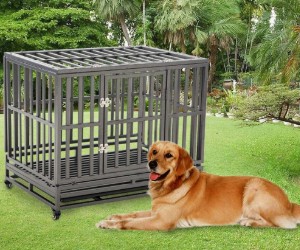 | LuckUp Heavy Duty Dog Crate Strong Metal Kennel and Crate for Large Dogs
| Check Price |
Retail pet shops offer a variety of crates for dogs. Some of these are spacious metal crates, soft fabric carriers, small plastic kennels, etc. Remember that there is no such thing as ‘free size when it comes to crates. It is your choice as the owner to buy the best box for your dog.
You may also like
Best Dog Crates, Pet Carriers and Kennels Review
Metal Crate
It’s normal for puppies to chew everything. But it’s still best to train your dog not to eat everything and protect your home from destruction. For instance, the best choice is a metal crate.
Plastic Kennel
Plastic kennel gives the best feeling of safety because of its durable walls. Plus, they’re easy to clean. But the downside is, they’re not well-ventilated and only suitable for transportation.
Soft-sided Carrier
Carriers made of fabric are the best for dog shows or any kind of traveling on the road. However, it’s not durable so it is not recommended to leave your dog unattended. On the other side, this type of crate is lightweight and foldable when not in need.
Buying your first crate? Go further and find out all the details.
Where should I Place a Crate?
The main reason for buying a crate is to help your dog easily adjust to the new surroundings and not to feel alone. Proper crate training will help your dog to understand that his crate if his own space and safe haven. He will be used to staying inside during the wee hours or when the whole family is together.
Remember, do not put the crate next to the hot or cold area in your house. Heat and cold are not good for your dog’s health. In terms of hygiene, the children’s room or kitchen is not a good place for your dog to stay.
What to Put into a Crate?
- Put a comfortable dog bed inside
- Keep your dog hydrated in a crate and provide him with enough water. Special water dispenser bowl is the best.
- Put his favorite toys inside. They help to cope with anxiety and boredom. Snuggle toys with heart bit are an excellent solution for puppies at night.
How to Crate Train a Giant Schnauzer?
5 Things You Should NEVER Do When Crate Training a Giant Schnauzer
- Do not use the crate as a form of discipline
- Do not leave your dog in a crate with other accessories on the body (leash, collars, etc)
- Do not force your dog to go into the crate
- The crate is not a substitute for daily walking or exercise
Basic Rules to Crate Train a Giant Schnauzer Puppy
Your dog’s first introduction to his new space should be warm and uplifting as much as possible.
- Praise your pet for every step that he does when you introduce the crate (sniffing, going inside, etc.) Give him all the encouragement to attract his interest. This is the first stage, don’t pressure him, make him feel that he desires to know what’s inside and not his owner. Do not limit his time indoors nor force him to get out. Give him the must-haves to make him comfortable (bed, toys, treats, etc.)
- When he’s starting to feel comfortable, try to close it for a short while, then open, and praise him. Then let him out. On the other hand, if your Giant starts to whine or bark, ignore the behavior, and wait until he calms down, let him out.
- It’s a good sign that he’s already considering his space when your pup starts dragging some stuff like toys into the crate. It’s your main goal!
- You can gradually increase the lock-up time from a couple of minutes to an hour – up to 8 or 10 hours.
- Do not ever forget to leave the water before you leave. Dogs can tolerate staying in the crate without food, but not without water.
- The best time to get your dog inside the crate at night is when he is already calm or tired.
Remember!
Locking up your pet won’t make him obedient or socialized. Those are two different things. Having a crate is to protect your home from getting destruction, but it does not mean that it will give the proper training for socialization and other behaviors. When you’re not around, try to make up for the lack of social activities and communicate with him as soon as you get home or when you’re at home.
7 Tips for Initial Crate Training a Giant Schnauzer Puppy
- The first thing to do is to walk your dog. Then take off his collar to avoid awful accidents in his crate. Use toys or treats to attract your dog, praise him with loving words and give him a treat when he enters inside. Remember, the crate should only cause positive emotions.
- The crate training should be uplifting to the mood. You can turn it into a mini-game. Leave the door open first then repeat it 10-20 times a day.
- Do not leave your dog in the crate for an extended period of time. When your dog starts to enter his home without uneasiness, try leaving him there for short periods of time. If, while in a crate, your dog is quiet and calm, praise him. If he barks or whines, ignore him until he calms down and then praise him.
- If your dog is being noisy, try covering the crate with something like a cloth. It’s normal that younger dogs are clingy, but whining and barking are not signs that he is not into the crate. He just wants to be with you.
- Gradually increase the crate training when you see that he’s starting to get comfortable. Do not forget to praise him every time he’s behaved. And don’t forget to walk your dog once you let him out.
- If your puppy falls asleep during class, don’t wake him up. When he wakes up, let him out and don’t praise him, play, caress him, or pay any attention to him for a few minutes. Let him think he’s loved much more when he’s in a crate. And don’t let the puppy out of the crate until he’s been quiet for 30 seconds.
- Once you close the crate door, try to spend some time close to your dog and talk to him about something to distract the uneasiness. If your puppy starts whining, distract him, smell his own fingers until he stops, and open the crate. Stay close to him. This training takes 5-10 minutes.
3 Tips to Keep your Giant Schnauzer Puppy in a Crate over Night
- Once your pup has learned the lessons above, it will now be easier to keep him in the crate at night. It’s important to tire him out, for example by playing or luring him to his crate. If he starts whining, put your hand, or slip your fingers inside and gently talk to him. Don’t get mad or yell at him.
- As a rule, a tired two-month-old puppy can sleep for four hours. If he wakes up in the middle of the night demanding to be released to go potty, let him do it. Take or take your puppy to a place where he is allowed to do that. If you want to take him outside, dress first, and then open the crate. After he’s done, put him in the crate without playing, turn off the light and go back to bed. If he starts whining again, give him your palm, and talk to him gently.
- It will take two or three nights to make him get used to this ultimately. In a week or two, try to leave the crate somewhere else in your apartment.
Final Tips to Leave a Giant Schnauzer Puppy in a Crate when You are out of Home
- Do not use force. Don’t forget to take off the collar once you invite him inside his crate.
- Close the crate and don’t talk about anything, just go and that’s it. But remember, do not leave him for more than 2 hours. If you are out longer than that, make sure that you have someone to feed your puppy and walk him around in your absence.
- Once you’ve done and mastered the training exercises above, it will be easier to make your dog stay in the crate when you leave home. Once you decide to leave him for a while, make sure that he’s tired and walked.
- If you’re consistent in training your dog, and you are firm in your demands, start to leave your puppy in the crate when you leave home or go to bed. You’ll eventually find your dog climb on his own. You will notice this happens when he’s sleepy, tired, or simply wants to be alone. When you’re at home, just open the crate door.
It’s believed that the time your puppy can spend in the crate without going out can be calculated by the formula:
Age in months + one month = the number of hours. For example, a 2-month-old puppy can stay in a crate for 3 hours.
How to Crate Train an Adult Giant Schnauzer?
If you’re going to crate train an adult dog, use the same technique for puppies. Make sure your dog walks safely into the crate after a toy or food without closing the doors. This is not difficult if you only feed him (!) in the crate.
After two or three days of training, encourage your dog to enter the crate without giving or showing anything. Praises, food, and toys should only be given when he comes the crate.
Give him a couple more days, then put there by command when feeding or giving him toys. Sit next to the crate, don’t close the door. Gradually increase the training time. Then try to close the crate for one to two minutes. If he barks or whines, ignore him. Praise him if he’s quite. Make your dog realize that barking is not a way to open the door.
It’s also important to let your dog know that you love him when he’s in the crate, so when he leaves the crate – don’t mind him for a few minutes.
Continue doing this as you increase his stay inside. Avoid harsh words and violence. Be patient, as it takes a couple of months for an adult dog to stay in his crate. After that, it will be easier for you to crate train your dog at home or when traveling.
Summary
Train the Giant Schnauzer correctly and let him know that crate is his personal space. Crate training is the best option to make the pup feel comfortable also when traveling. This way Giant Schnauzer feels secure and protected. It takes a lot of patience and consistency to train you Giant Schnauzer. But after finish, you and your dog will surely benefit.
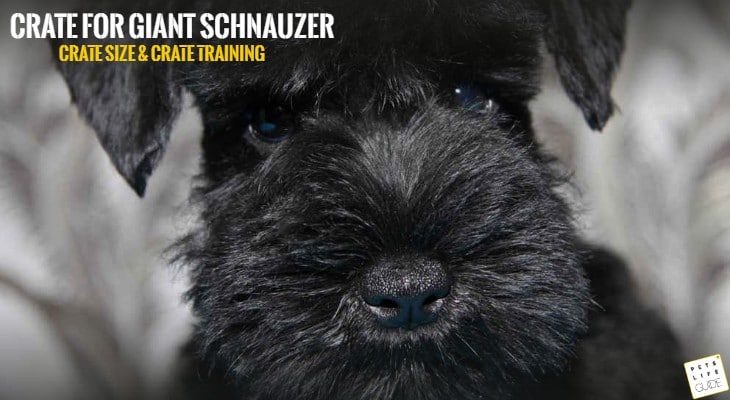
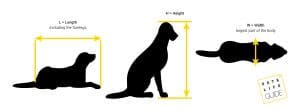
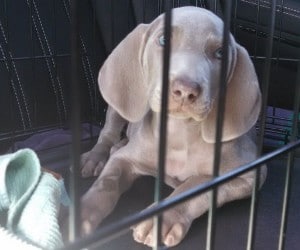

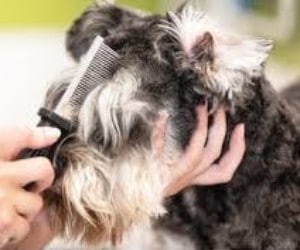

Leave a Reply